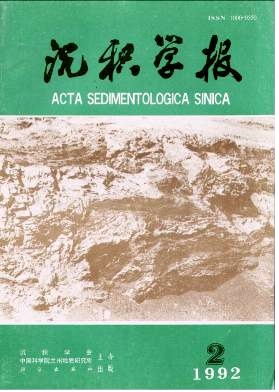Mei Zhichao, Lu Huanyong, Li Wenhou. Bedded Radiolarian Cherts in the Ordovician of Weibei, Shaanxi[J]. Acta Sedimentologica Sinica, 1992, 10(2): 9-18.
| Citation:
|
Mei Zhichao, Lu Huanyong, Li Wenhou. Bedded Radiolarian Cherts in the Ordovician of Weibei, Shaanxi[J]. Acta Sedimentologica Sinica, 1992, 10(2): 9-18.
|
Bedded Radiolarian Cherts in the Ordovician of Weibei, Shaanxi
- Received Date: 1991-04-15
- Publish Date:
1992-06-10
-
Abstract
The radiolarian cherts in the Wenbei region of Shaanxi Province are a formation of pelagic sediments formed within the North China Platform. These radiolarian cherts are black in color, composed mainly of chalcedony, abound in "ghosts" or netted skeletons of radiolarians and show well-devoloped liminations. They contain some interbedded thin siliceous shales, and in stratigraphic section are associated with turbidite limestones and tuffs. The well visible relict organic texture and diagenetic replacement fabrics in the cherts suggest that the rocks are chiefly derived from biogenic opals by dissolution-reprecipitation processes during the early diagenetic stage, while free SiO2 released by volcanic ash constitutes a very limited content. In terms of age, the radiolarian cherts in the Weibei region can be correlated to the Caradocian stage of the Middle Ordvician. This corresponds to a time when there was a rise of the global sea level, and when the ancient Qinling ocean basin was undergonig vigorous spreading and subduction. The subsidence occurred in the southern margin of the North China Platform made a deep-water back-arc basin on its northern margin which lay in the Weibei region. During this period, the study area was located right within low latitudes of the eguator. A broad shallow water carbonate platform which existed to the north of North China impeded effectively the introduction of terrigenous clastic sediments into the basin from the north. The widespreded bedded cherts in the Qinling region indicates that the open sea was a zone of up welling ocean currents characterized by high planktonic organism productivity. All these factors were favourable conditons for the deposition of radiolarian cherts. Becaues calcareous planktonic organisms had not yet flourished at that time, radiolatian chert deposition might not have been controled by CCD, and the water depth probably was much shallower than that of their modern analogue.
-
References
|
[1]
|
(1) 付力浦,1981,中国地质科学院院报(西安地质矿产研究所听刊)第2卷,第l期,105-111页.
(2) 安太库、张安泰、徐建发,1985,地质学报,第2期,97-107页.
(3) 甘肃省地层表编写组,1980,西北地区区域地层表(甘肃省分册),124-144页及173-195页,地质出版社.
(4) 许靖华,1984,海洋学报,第6卷,第6期,E29-842页.
(5) 陈均远,1!)88,古生物学报,第27卷,第3期,331-345页.
(6) 严阵等,1985,陕西省花岗岩,53-146页,西安交通大学出版社.
(7) 张秋生、朱永正,1984,长春地质学院院报,第3期,1-13页.
(8) 金若谷,1987.地质论评,第33卷,第3期,283-24$页.
(9) 张国伟、梅志超、周鼎武、孙勇、于在平,1988,秦岭造山带的形成及其演化,1-16页,西北大学出版社
(10) 杨志超、刘剑、金勤海,1984,陕西地质,第2卷(增刊),20-23页.
(11) 张国伟、孙勇、于在平、‘薛峰,1988,秦岭造山带的形成及其演化,46-64页,西北大学出版社.
(12)吴汉宁、常承法、刘格、钟大赉,1991,地质科学,第3期,201-214页.
(13) 佩蒂庄,1975,沉积岩〔李汉渝等译),423-435页,石油工业出版社.1981.
(14) 梅志超、陈景维、卢焕勇、李文厚,1982,石油与天然气地质,第1期,49-56
(15) 梅志超、李文厚,1986,沉积学报,第4卷,第1期,34-42页,
(16) 童玉明、周祖勋,1985.沉积学报、第3卷,第2期.67-74页.
(17) 琼斯.默切,1986,古生代和中生代放射虫镬石岩的地质意义,国外地质科技,1987,第4期,1-20页
(18) BaltmkM,1982, Sedimentary Geology, No.31, p.63-88
(19) Blatt fi.. 1982. Sedimentary Petrology, p.380-399, W. H. Freeman and Company. San Francisco
(20) Blatt H., Middleton G.. Murray R., 1981,Origin of Sedimentary Rocks, p.571-586, Prentice-Hall. Inc, Englewood Cliffs. New Jersey.
(21) Chen Jun-yuan. 1988, New M exico Bureau of Mines and Mineral Resources Memoir.V.44. p.387-404
(22) Dickinson W.R,1974.、Modern and Ancient Creosyclinal Sedimentation (Ed. by R.H.Dott Jr and R.H.Shaw'r), SEPM. p.292-303
(22) Dickinson W.R,1974.、Modern and Ancient Creosyclinal Sedimentation (Ed. by R.H.Dott Jr and R.H.Shaw'r), SEPM. p.292-303
(23) Hesse H.. 1988, Geoscience Canada, V.15, No.3. p.171-192
(24) Jenkyns H.C.,1978, Sedimentary Environments and Facies ( Ed. by H.G. Reading),p.314-371?Blackwell Scienlil3c Publications. Oxford.
(25) Mitchell A. H. G. and Reading H. G.,1978, Sedimentary Environments and Facies(Ed. by H. G. Reading), p.439-479, Blackwell Scientific Publication.Oxford.
(26) Rad U. V'.,and Rosch, 1974, Pelagic Sediments: On Land and Under the Sea(Ed. by K.J Hsu and H.C.Jenkyns),
(27) Wise S.W.1R. lnt. Ass. Sedimentol. Spec. Pub.No.l,p.327-342
and Weaver F.M.,1974, Idem. p.301-326
(28) Scholl P.A., 1979, Deposition, Diagensis, and Hydrocarbon Potential of Deeper-Water-Limestones. Commu ing Education Course Note Series 7. AAPG. Deparment of Education.p.10-11
(29) Steinberg M., et al,1977. Sedimentology. No.24, p.547-563. |
-
-
Proportional views

-






 DownLoad:
DownLoad: